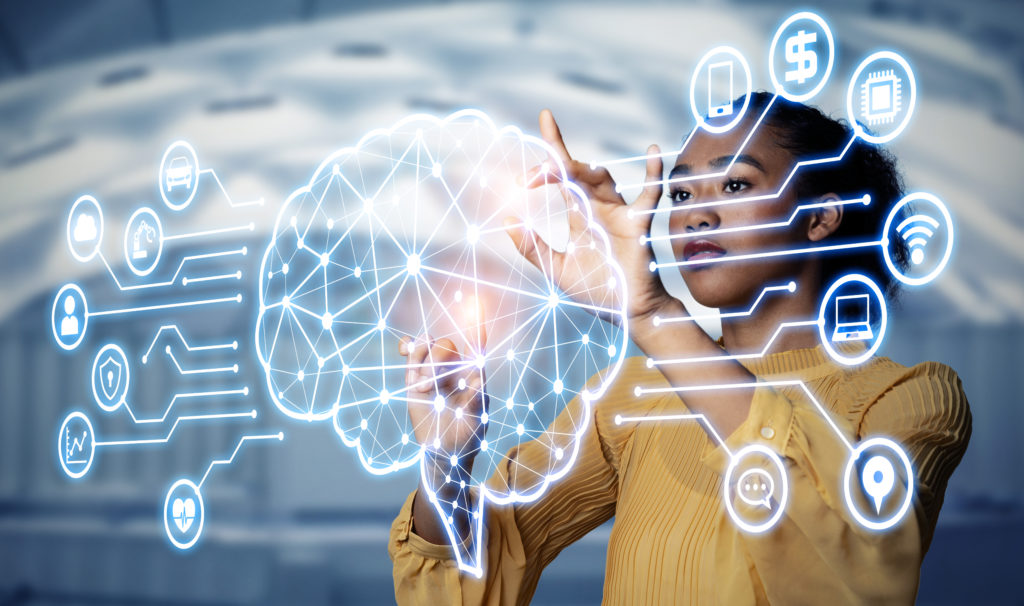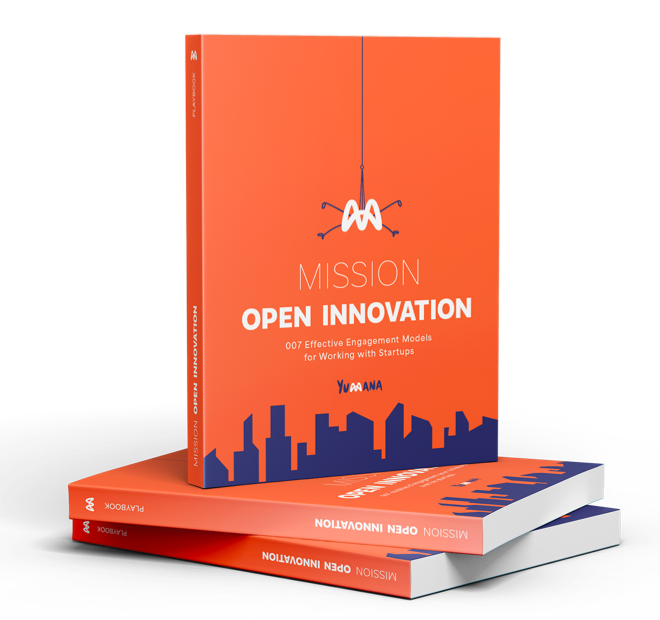In just a few months, artificial intelligence has undergone a dramatic shift. It has moved from being a technology with a sci-fi aura to becoming a tangible reality. A reality that continues to evolve at a rapid pace. Take, for example, the meteoric rise of ChatGPT and the 18% of French people who use it every week*. This leads us to ask: how has AI—and more specifically, generative AI—become a driving force for innovation?
Before diving into the heart of the matter, it’s essential to understand what generative AI truly is, and to analyze the mechanisms underlying what we call the “innovation process.”
What is artificial intelligence, and why are we talking about generative AI?
Artificial intelligence is often seen as a vast, multidimensional, and constantly evolving concept—making it difficult to define precisely. So, let’s go back to its origins. One of the field’s pioneers, John McCarthy, defined artificial intelligence as “the science and engineering of making intelligent machines.”
According to the European Parliament, AI refers to any system used by a machine to replicate behaviors associated with humans, such as reasoning, planning, and creativity. For instance, AI can be found in simple recommendation algorithms on streaming platforms, but also in more complex systems such as autonomous driving.
Generative AI, meanwhile, is a type of artificial intelligence capable of creating new content—such as text, images, or music—by learning from existing examples. The term “generative AIs” is used in the plural because there are various types and models of such systems, each specialized in generating different kinds of content using diverse techniques and architectures.
Here are three key points to keep in mind:
Depending on your needs, there are generative AI solutions capable of producing a wide variety of content: text (e.g., ChatGPT), images (e.g., Midjourney), videos (e.g., Sora), presentations (e.g., Gamma), music (e.g., Mubert)…
AI systems can be probabilistic: rather than following strict, deterministic rules, a probabilistic AI evaluates different possibilities and selects the most likely outcome, taking into account uncertainty and the unpredictability of data.
The economic impact of AI adoption is undeniable. We’ve moved past the prediction phase—early results are in: over 40% of organizations implementing AI have seen real cost reductions, while 60% have reported increased revenue (a 10-point jump compared to 2022 – BCG study).
Their name says it all—generative AIs are inherently tied to a self-renewing innovation process.
* Source: Reuters Institute for the Study of Journalism | YouGov, CNIL

But what exactly is innovation?
Innovation refers to the introduction to the market of a new or significantly improved product or process compared to what has previously been developed. There are various ways to foster innovation within a company.
Innovation management enables the emergence of innovative projects and maximizes their performance. For example, by launching a corporate innovation initiative, companies can build an innovation culture among their teams to design and improve products and services.
Artificial intelligence stems from a breakthrough innovation and, in turn, drives numerous other innovations. This is known as the concept of innovation becoming an innovator—a virtuous cycle of prolific innovation.
How Does Artificial Intelligence Drive Innovation?
It’s clear by now—AI has the potential to revolutionize every industry. It acts as a catalyst for innovation by opening new possibilities, increasing efficiency, and unlocking the creative potential of individuals and organizations.
There are many benefits to using AI within an innovation process:
Accelerating the innovation process
AI enables the rapid analysis of large volumes of data, uncovering trends and patterns that speed up the ideation phase and the development of new products or services.Improving the precision and quality of products and services
By automating certain tasks and delivering advanced analytics, AI helps reduce human error and enhance the quality of innovative offerings.Customizing and adapting solutions
AI allows for the creation of personalized, innovative solutions tailored to the specific needs of users—leading to better customer satisfaction and stronger loyalty.Identifying new opportunities
Through data analysis and trend detection, AI can reveal untapped market opportunities or areas for innovation that might have otherwise gone unnoticed.Optimizing resources
By automating processes and offering data-driven recommendations, AI helps optimize resource utilization—resulting in cost savings and greater operational efficiency.Fueling creativity
AI tools can act as catalysts for human creativity by providing suggestions, generating ideas, or even producing creative content—enriching the entire innovation process.
In short, AI is transforming how we conceive and implement innovation. It helps us make sense of the data we collect, spark new ideas, and deliver more effective solutions. AI accelerates and sharpens our innovation processes.
But a word of caution… these technologies are not without risks! A piece of advice: always stay alert to potential pitfalls when using AI.
The 5 Mistakes to Avoid When Integrating AI into an Innovation Process
Relying solely on AI
As the name suggests, artificial intelligence is not human. It’s essential to integrate human expertise and experience into the innovation process to ensure relevant and meaningful outcomes. For instance, AI lacks emotions and true creativity.Underestimating the need for quality data
AI often relies on data to produce accurate results. Ensuring that the data used is relevant, accurate, and representative of the problem to be solved is critical. Overlooking the importance of data quality can lead to unreliable or biased outcomes.Overestimating AI
It’s tempting to take AI-generated results at face value, but it’s important to remember that AI models can be subject to bias, limitations, or even generate what are commonly referred to as “hallucinations.” A still too frequent occurrence, these hallucinations refer to false answers provided by generative AI when questioned. One well-known example is Google Bard’s 2023 mistake, where it incorrectly attributed the first photo of an exoplanet to the James Webb Space Telescope. The backlash was swift: in just one day, the tech giant lost $100 billion in market value. Relying solely on AI outputs without a deep understanding of how the technology works can be very costly.
Overlooking ethics
AI can raise major ethical concerns such as data privacy, intellectual property, algorithmic discrimination, and accountability in case of errors.
Take the New York Times, for instance, which filed a lawsuit in December 2023 against ChatGPT for copyright infringement. By training on millions of protected articles, the AI allegedly caused financial harm to the newspaper, estimated in the billions of dollars.
This doesn’t mean you shouldn’t use generative AI, but if you plan to incorporate it into your innovation process, it is essential to integrate ethical considerations from the outset and continuously evaluate their implications throughout the project.Sticking to a one-size-fits-all approach
There is a wide range of AI techniques and approaches, each with its strengths and limitations. It’s important to stay open to exploring various methods and adapt according to the specific needs of your project.
Take the example of managing an advanced e-commerce platform: different AIs could be used for product recommendations, natural language processing, customer service, and inventory management.
When integrating AI into a company’s innovation process, it’s essential not to jump in headfirst. Strategic thinking and iterative experimentation are key to optimizing results.
This need for careful thought is even more critical when it comes to corporate innovation. Enhancing this approach by introducing AI involves a dual challenge: familiarizing employees with innovation and raising awareness of AI.
But this must be done thoughtfully.
Let’s look at a study by BCG in 2023, conducted as OpenAI launched ChatGPT Enterprise. It analyzed the impact of generative AI on productivity and creativity at work. The findings were mixed and thought-provoking: in creative workshops, users of GPT-4 generated 41% fewer diverse ideas than groups not using the technology. Paradoxically, generative AI did improve the quality of contributions from employees working individually.
So let’s ask ourselves:
Are AI and corporate innovation truly compatible? Does generative AI positively impact innovation program performance?
These are questions explored by Ofer Attali, CTO of Yumana, in his analysis of the relationship between AI and corporate innovation.

Artificial Intelligence and Corporate Innovation
In large organizations, tens of thousands of employees may potentially take part in a corporate innovation initiative. Even if only 10% actively participate, that could result in hundreds of ideas, suggestions, and comments per day. Naturally, it’s impossible to manually sort through all these contributions.
Another key takeaway from the aforementioned BCG study highlights the significant performance gains linked to the use of generative AI in creative work—and by extension, ideation.
When using GPT-4 for creative tasks (such as generating new product concepts), about 90% of participants reported an average performance boost of 40% compared to those completing the same task without GPT-4.
That’s why artificial intelligence and collaborative innovation are inseparable concepts, and integrating AI into a platform is highly strategic.
How Can Generative AI Be Used in Corporate Innovation?
Deep Learning
Let’s go back to the basics. AI isn’t magic, it belongs to a family of mathematical methods. Generative AI is one of the most recent additions to this vast family.
More precisely, it’s a subfield of a subfield of a subfield of AI. Let’s trace it back to deep learning, a sub-discipline of machine learning. In brief, machine learning encompasses a range of statistical learning methods that enable systems to make predictions based on past data.
Deep learning, in turn, develops what are called deep neural networks. These networks involve multiple layers of interconnected “neurons”—composed of weights and mathematical functions—that learn hierarchical representations of data.
And generative AI? It’s essentially a product of deep learning. Every piece of information is analyzed, decoded, and interpreted based on previously received data.
Thanks to modern technologies and deep learning, computers can now learn by example. The more varied experiences the system accumulates, the more efficient it becomes. However, this technology requires significant computational power to train neural networks.
Now, let’s apply this to corporate innovation platforms. The AI learns from users’ behavior on the platform and can suggest personalized content (articles, idea recommendations, etc.) based on interests and interactions.
This approach mirrors what platforms like Netflix or Amazon already do. Likewise, an innovation management platform can go even further by offering AI-powered recommendations.
Take, for instance, a corporate intrapreneurship program manager who, after selecting ideas and candidates, must form teams capable of executing top projects. Using a profiling tool (which analyzes users’ skills, soft and hard competencies, availability, motivation…), an AI-powered platform can build the most relevant multidisciplinary teams. Think of it as a kind of “Tinder for innovation.”
A Decision-Making Support Tool
AI is crucial for collaborative innovation because it helps companies make better decisions. It’s a support tool that enhances human capabilities to work faster, process large volumes of data, and provide decision-makers with objective insights and KPIs to guide high-stakes decisions.
AI can distinguish between repetitive, less impactful topics and truly strategic, innovative ideas. With in-depth analysis, it can surface the right insights at the right time to support informed decision-making at the top level.
What Are the Benefits of AI in a Corporate Innovation Program?
Without this technological component, a participatory innovation tool is essentially just an idea box that must be manually reviewed—a huge and unsustainable workload. But AI brings much more than just efficiency.
1. It Boosts Engagement
A dedicated platform is essential for the success of any collaborative innovation initiative. This is where employees post, enrich, and comment on contributions, much like a social media feed.
AI highlights topics most likely to spark interaction, based on user profiles—ensuring everyone sees content relevant to their interests.
Driving engagement is crucial to encouraging repeat participation. While other factors also matter, a personalized user experience is now key to ensuring employee loyalty to the initiative.
2. It Surfaces the Most Relevant Topics
No one can keep up with everything. Choices must be made and AI adds real value to this process.
Topics are prioritized based on the daily challenges of employees, while also including peripheral themes that may catch their interest.
This profiling system doesn’t just rely on professional attributes, it can also take into account personal interests to further increase engagement.
To be truly helpful, the platform should avoid showing content irrelevant to a user’s skills or interests.
Additionally, if the personalized experience is seamlessly integrated, the user can also query the platform in natural language to find information, experts, or even business partners—a new dimension made possible by AI.
3. It Creates a Marketplace for Innovative Co-Creation
A market is defined by supply and demand—when these align, everything flows smoothly.
Corporate innovation, enhanced by AI-powered decision-making, functions much like a marketplace:
The supply lies in proposals and ideas for improvement or creation.
The demand comes from the willingness to participate and engage.
AI’s role is to balance supply and demand to satisfy all stakeholders. That means promoting valuable “hidden gems,” while avoiding the selection of low-engagement contributions.
It also involves spotlighting enriching conversations that truly benefit contributors.

CTO de Yumana



